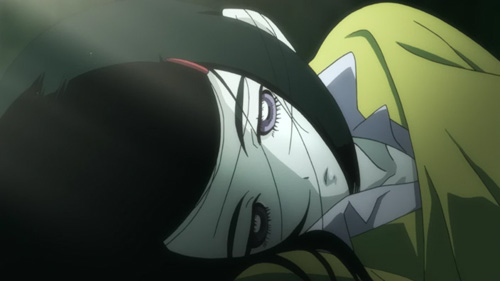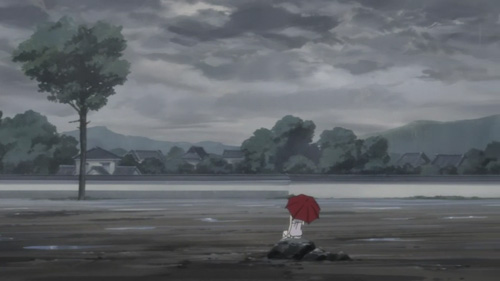Ghost in the Shell: Arise marks Production IG’s attempt to reboot the classic franchise. With multiple successful superhero and anime reboots out in the wild, it’s only a matter of time before others (certainly Dragonball) get remade. Movie and television producers reboot well loved shows to appeal to modern audiences. The story, the characters, and the special effects all get updated to how the show would have looked if it was made for the first time today. With Ghost in the Shell, a show already set in the future and one that has aged well visually, this standard formula wasn’t really necessary.
Tag: production i.g.

“There’s a field of thought which postulates that the only reason this universe exists is because we humans do. […] I’m consumed by the thought that this world itself may be nothing but an illusion. That “Snark” in the Abstract World may be my real self, and my physical body here just a hologram.“
The suggestion that there might be a level of consciousness beyond the physical realm has fascinated people for thousands of years. Are we tied to these bodies forever, or, could this vague concept of “we” be a mere illusion; a solid container that our ‘ego’ is ready to transcend at any given moment? Science has one answer (neurology), religion offers another. While striving to understand this ambiguous essence of our individuality (or “soul”) forever remains man’s greatest quest in life, it’s ironic that the only true answer lies in his death. Ghost Hound is a very literal attempt to answer, or at least, ask those same questions.
Looking over his work, investigation of spirituality often appears in the writing of Masamune Shirow. After all, his most famous creation is Ghost in the Shell; the whole concept of which is built around cyborg Motoko Kusanagi’s search for a (or indeed, her own) soul. Within four episodes, Shirow‘s Ghost Hound has established that several characters are capable of interacting during out-of-body experiences, but unlike Ghost in the Shell, it isn’t so concerned with trying to discover, or define, that ‘ghost’ as much as how our perception of that existence remains shrouded in mystery; a mystery not even fathomed by scientists who boldly claim to understand life and enjoy “playing god” with their genetic experiments under the guise of medical advancement.

Masamune Shirow: “The present animated TV series has slightly changed the original theme and focuses on the “loss of unworldly power and transformation to an alien being called adults” as it reveals a story of three junior high school students coming into contact with the adult world.“
All this talk of spirituality is brought to the fore by Ghost Hound‘s intimate portrayal of loss of youth. Taro’s family still haven’t come to terms with the death of his sister; his grieving mother continuing to lose grip of her sanity. Makoto’s family were blamed for that death; his mother abandoned him and his father committed suicide. Masayuki’s family are just plain loveless and cold. Haunted by this past (and present) trauma, the boys bond together and adventure into a world of ghosts and imagination. People (including Mitsuhisa Ishikawa (the president of Production I.G)) have compared Ghost Hound to Stand By Me, it’s a great comparison because despite its sci-fi overtones, it’s a very emotional and moving coming-of-age journey that deals with a group of kids who, up until this point, haven’t been able to cope with the tragedy that has forever tainted their innocence.
Ryutaro Nakamura: “In an extreme sense, one could say that human existence itself is horrifying. And there are many approaches and directions we can choose in the process of speculating about what exactly this thing we call “existence” actually is.“
Director Ryutaro Nakamura, whose previous work includes Serial Experiments Lain and Kino no Tabi, is interesting, in that he regularly blends his artsy, abstract touches with symbolic human drama. Ghost Hound could quite easily degenerate into an alienating Ergo Proxy-esque philosophical exercise, but it never felt like that for me, it’s as if I can always understand what he’s trying to say. It’s quite an achievement when you consider that Nakamura and writer Chiaki J. Konaka have created a story here that regularly ponders mysticism and spirituality without ever compromising intimacy of feeling with the viewer. In particular, I’d like to note Nakamura‘s distinct use of sound; the almost negligible humming of power cables over head, the constant whirring of machinery and the dissonancent noise of a badly tuned radio. His unique mingling of discordant, unnatural sounds often creates an atmosphere of surreal ill-ease.

“In 2008, Massey University professor Brian Whitworth stated that all physical phenomena in the universe can be explained in terms of information. Therefore, what we perceive as reality is in fact a virtual reality run by someone on a computer.“
I still haven’t seen the last episode of Ghost Hound and I’m not convinced I’ll find an easy answer to every question it has raised. But that’s fine. In this case, being thought-provoking is enough. I don’t want a scientific explanation to try and rationalise the supernatural, or reality, or the source of life. The mystery is more engaging and more important than any answer.

As any fans of Evangelion will attest, it’s rare to finish an anime series and find ourselves contented enough to walk away knowing “everything is tied up into a neat little package”, yet that is the case with the recently concluded Guardian of the Sacred Spirit (a.k.a Seirei no Moribito). An (evil) part of me will always demand an epic train-wreck, a sensational massacre of violence, death and angst, but deep down, I always knew it would never happen with straight-laced Seirei no Moribito – it was certainly predictable; morally as straight as an arrow, and that’s not necessarily a bad thing.
It’s been a few years since I last enjoyed a Production I.G. TV series. The "mega-hit" Blood+ was a safe and predictable action series, while the elegant period setting of Le Chevalier D`Eon was dull and uninspired. All that is to say, I suppose I was expecting to be bored when watching Seirei no Moribito (a.k.a Guardian of the Sacred Spirit); it’s funny how wrong one’s expectations can be, and it’s subsequently great to be proven so profoundly wrong.
Based on the first of 10 fantasy novels by Shihoko Uehashi, Seirei no Moribito follows a precocious female warrior turned bodyguard called Balsa. The story so far is that it’s her job to protect the young Prince Chagum, a kind hearted member of the Royal family who has been "possessed by a water spirit" and since targeted for assassination by his own father (the Emperor). Amidst flames and confusion, Balsa flees the royal palace with Chagum in tow, hunted by the Emperor’s finest warriors.
Let’s get this obvious fact out of the way; Seirei no Moribito is a gorgeous example of high budget animation. With Production I.G., you expect lavish and detailed background art, but rarely do you see such objective, rural beauty in an anime TV series. Only Mushishi comes close to this obsessive reflection of nature. The art director is Yusuke Takeda, who was also behind both the stylised look Gankutsuou and the grandiose feel of Giant Robo. Takeda’s got talent.
It’s obvious that Seirei no Moribito is based on a novel, not only is the story deceptively straight forward and unconcerned with pointless details, the characterisation is striking and unique; the product of a seasoned and talented writer. Chagum isn’t the stuck up prince we expect him to be and Balsa isn’t a cold and efficient killer either, their personalities feel essentially human, different to what we expect.
It’s hard to write a review when you enjoy something so much, but stick with me; I’m not saying all this just to fill time. The director is Kenji Kamiyama, he of Stand Alone Complex fame. Indeed, Kamiyama is a steady and assured hand, never attempting to impose a distinct style on the narrative, preferring instead to let the story unfold at a natural pace.
No doubt, the soundtrack is my favourite of the spring season. It’s composed by the world famous Kenji Kawai, revered for his work on the Ghost in the Shell movies. Here his ethereal, emotional music bleeds into the animation, giving absolute life and emotion to the landscapes and wildlife that surrounds the characters. It’s particularly notable when Chagum scales a slippery, dangerous cliff. At the top, he finds a wolf; the background is filled with rain and lightning, the fearsome animal stands there starring at him, then just turns around and walks back down the cliff. The music during this moment is a heart stopping and tense epic; I need the soundtrack now!
I’ve saved the best for last; the action. I thought Tengen Toppa Gurren Lagann had some fluid hand to hand combat, but episode 3 of Seirei no Moribito rivals the famous "rain" episode from Samurai Champloo. The warrior costumes, their unconventional weapons (spears!) and the actual battle choreography is absolutely electric. There is no real "style" or posing to speak of; it’s real fighting, skirmishes that are often over within 10 seconds, but what a 10 seconds!
It’s hard to summarise a series I’ve enjoyed watching as much as the first three episodes of Seirei no Moribito. It’s already licensed by Geneon in the US, so expect a DVD release state-side soon enough, and the actual novels are going to be published too (in North America by Scholastic). Since Seirei no Moribito is simply the first book, I can only hope that this is the beginning of another big franchise for Production I.G.